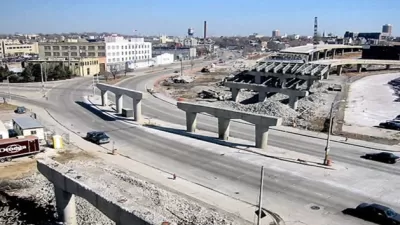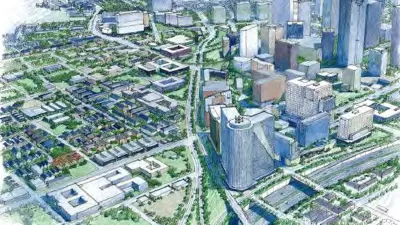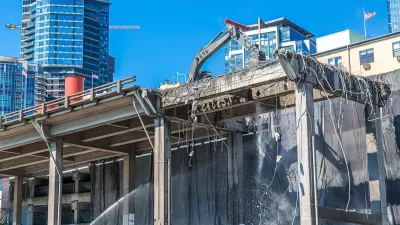A proposal to replace the elevated Interstate 794 with a boulevard could create over a billion dollars in new development along the corridor.

A new report outlines the potential benefits of replacing a portion of Interstate 794 in Milwaukee with an at-grade boulevard to create more space for development and other uses.
As Jeramey Jannene explains in Urban Milwaukee, the Rethink 794 proposal could spur more than $1.1 billion in development and 3,000 new housing units in the 30 years following the change, according to the analysis by Larry Witzling. “The 10-block corridor would likely be redeveloped from the inside outside, according to Witzling’s analysis. Much of the initial development would take place near the Milwaukee Public Market, while new parks could be created closer to the lake.”
Witzling’s analysis shows that even with a four-lane road, removing the elevated highway would create more space for housing and other uses. “The Wisconsin Department of Transportation (WisDOT) previously said it would release two design alternatives for further study this year. One is expected to be a freeway-to-boulevard replacement, while another would be a roadway narrowing.”
FULL STORY: Converting 794 To Boulevard Could Yield 3,000 Housing Units, $1.1 Billion in Development

Trump Administration Could Effectively End Housing Voucher Program
Federal officials are eyeing major cuts to the Section 8 program that helps millions of low-income households pay rent.

Planetizen Federal Action Tracker
A weekly monitor of how Trump’s orders and actions are impacting planners and planning in America.

The 120 Year Old Tiny Home Villages That Sheltered San Francisco’s Earthquake Refugees
More than a century ago, San Francisco mobilized to house thousands of residents displaced by the 1906 earthquake. Could their strategy offer a model for the present?

HSR Reaches Key Settlement in Northern California City
The state’s high-speed rail authority reached an agreement with Millbrae, a key city on the train’s proposed route to San Francisco.

Washington State Legislature Passes Parking Reform Bill
A bill that would limit parking requirements for new developments is headed to the governor’s desk.

Missouri Law Would Ban Protections for Housing Voucher Users
A state law seeks to overturn source-of-income discrimination bans passed by several Missouri cities.
Urban Design for Planners 1: Software Tools
This six-course series explores essential urban design concepts using open source software and equips planners with the tools they need to participate fully in the urban design process.
Planning for Universal Design
Learn the tools for implementing Universal Design in planning regulations.
Ada County Highway District
Clanton & Associates, Inc.
Jessamine County Fiscal Court
Institute for Housing and Urban Development Studies (IHS)
City of Grandview
Harvard GSD Executive Education
Toledo-Lucas County Plan Commissions
Salt Lake City
NYU Wagner Graduate School of Public Service





























